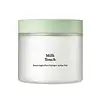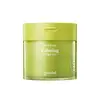What's inside
What's inside
 Key Ingredients
Key Ingredients

 Benefits
Benefits

 Concerns
Concerns

 Ingredients Side-by-side
Ingredients Side-by-side

Water
Skin ConditioningMethylpropanediol
SolventGlycerin
HumectantDipropylene Glycol
HumectantButylene Glycol
Humectant1,2-Hexanediol
Skin ConditioningHydroxyacetophenone
AntioxidantPanthenol
Skin ConditioningCaffeine
Skin ConditioningPotassium Alum
AstringentErythritol
HumectantSodium Citrate
BufferingCaprylyl Glycol
EmollientAllantoin
Skin ConditioningPolyglyceryl-10 Laurate
Skin ConditioningPropanediol
SolventEthylhexylglycerin
Skin ConditioningChlorella Vulgaris Extract
Skin ConditioningGlucose
HumectantPentylene Glycol
Skin ConditioningFructooligosaccharides
HumectantFructose
HumectantTrisodium Ethylenediamine Disuccinate
Acetyl Glucosamine
Skin ConditioningAlthaea Rosea Flower Extract
Skin ConditioningSodium Hyaluronate
HumectantSaccharomyces Ferment Filtrate
HumectantPyrus Malus Fruit Extract
Skin ConditioningSodium Hyaluronate Crosspolymer
HumectantAlbatrellus Confluens Extract
HumectantBetaine Salicylate
AntimicrobialCitric Acid
BufferingArgania Spinosa Kernel Oil
EmollientSesamum Indicum Seed Oil
EmollientRhus Semialata Gall Extract
Skin ConditioningEnantia Chlorantha Bark Extract
Skin ConditioningSerenoa Serrulata Fruit Extract
Skin ConditioningTremella Fuciformis Extract
HumectantBeta-Sitosterol
Emulsion StabilisingTocopherol
AntioxidantHydroxypropyltrimonium Hyaluronate
Hydrolyzed Collagen
EmollientOleanolic Acid
Skin ConditioningHydrolyzed Hyaluronic Acid
HumectantSodium Acetylated Hyaluronate
HumectantHyaluronic Acid
HumectantHydrolyzed Sodium Hyaluronate
Skin ConditioningPotassium Hyaluronate
Skin ConditioningWater, Methylpropanediol, Glycerin, Dipropylene Glycol, Butylene Glycol, 1,2-Hexanediol, Hydroxyacetophenone, Panthenol, Caffeine, Potassium Alum, Erythritol, Sodium Citrate, Caprylyl Glycol, Allantoin, Polyglyceryl-10 Laurate, Propanediol, Ethylhexylglycerin, Chlorella Vulgaris Extract, Glucose, Pentylene Glycol, Fructooligosaccharides, Fructose, Trisodium Ethylenediamine Disuccinate, Acetyl Glucosamine, Althaea Rosea Flower Extract, Sodium Hyaluronate, Saccharomyces Ferment Filtrate, Pyrus Malus Fruit Extract, Sodium Hyaluronate Crosspolymer, Albatrellus Confluens Extract, Betaine Salicylate, Citric Acid, Argania Spinosa Kernel Oil, Sesamum Indicum Seed Oil, Rhus Semialata Gall Extract, Enantia Chlorantha Bark Extract, Serenoa Serrulata Fruit Extract, Tremella Fuciformis Extract, Beta-Sitosterol, Tocopherol, Hydroxypropyltrimonium Hyaluronate, Hydrolyzed Collagen, Oleanolic Acid, Hydrolyzed Hyaluronic Acid, Sodium Acetylated Hyaluronate, Hyaluronic Acid, Hydrolyzed Sodium Hyaluronate, Potassium Hyaluronate
Water
Skin ConditioningGlycerin
HumectantButylene Glycol
Humectant1,2-Hexanediol
Skin ConditioningDipropylene Glycol
HumectantMethylpropanediol
SolventHouttuynia Cordata Extract
Skin ConditioningMelia Azadirachta Leaf Extract
Skin ConditioningMelia Azadirachta Flower Extract
Skin ConditioningAlthaea Rosea Flower Extract
Skin ConditioningTheobroma Cacao Seed Extract
AntioxidantCurcuma Longa Root Extract
MaskingOcimum Sanctum Leaf Extract
Skin ConditioningCitrus Aurantium Dulcis Peel Oil
MaskingOcimum Basilicum Oil
MaskingCorallina Officinalis Extract
Skin ConditioningLavandula Angustifolia Oil
MaskingErythritol
HumectantAllantoin
Skin ConditioningSodium Citrate
BufferingCaprylyl Glycol
EmollientPolyglyceryl-10 Laurate
Skin ConditioningPropanediol
SolventEthylhexylglycerin
Skin ConditioningCitric Acid
BufferingGlyceryl Acrylate/Acrylic Acid Copolymer
HumectantPvm/Ma Copolymer
Emulsion StabilisingDextrin
AbsorbentTocopherol
AntioxidantCaffeine
Skin ConditioningDisodium EDTA
Water, Glycerin, Butylene Glycol, 1,2-Hexanediol, Dipropylene Glycol, Methylpropanediol, Houttuynia Cordata Extract, Melia Azadirachta Leaf Extract, Melia Azadirachta Flower Extract, Althaea Rosea Flower Extract, Theobroma Cacao Seed Extract, Curcuma Longa Root Extract, Ocimum Sanctum Leaf Extract, Citrus Aurantium Dulcis Peel Oil, Ocimum Basilicum Oil, Corallina Officinalis Extract, Lavandula Angustifolia Oil, Erythritol, Allantoin, Sodium Citrate, Caprylyl Glycol, Polyglyceryl-10 Laurate, Propanediol, Ethylhexylglycerin, Citric Acid, Glyceryl Acrylate/Acrylic Acid Copolymer, Pvm/Ma Copolymer, Dextrin, Tocopherol, Caffeine, Disodium EDTA
 Reviews
Reviews

Ingredients Explained
These ingredients are found in both products.
Ingredients higher up in an ingredient list are typically present in a larger amount.
1,2-Hexanediol is a synthetic liquid and another multi-functional powerhouse.
It is a:
- Humectant, drawing moisture into the skin
- Emollient, helping to soften skin
- Solvent, dispersing and stabilizing formulas
- Preservative booster, enhancing the antimicrobial activity of other preservatives
Allantoin is a soothing ingredient known for its protective and moisturizingg properties. Because of this, it is often added to products with strong active ingredients.
Studies show higher concentrations of this ingredient can promote wound healing.
Though it can be derived from the comfrey plant, allantoin is produced synthetically for cosmetic products to ensure purity.
Learn more about AllantoinThis ingredient comes from the hollyhock flower. It has skin conditioning properties.
Butylene Glycol (or BG) is used within cosmetic products for a few different reasons:
Overall, Butylene Glycol is a safe and well-rounded ingredient that works well with other ingredients.
Though this ingredient works well with most skin types, some people with sensitive skin may experience a reaction such as allergic rashes, closed comedones, or itchiness.
Learn more about Butylene GlycolCaffeine is most associated with coffee, tea, and cacao. In skincare, it helps with calming inflammation and is rich in antioxidants.
While caffeine is used to treat cellulite and and dark circles, further studies are needed to prove this. It has been believed to help with these skin conditions due to its ability to dilate blood vessels and increase blood flow.
Some studies are looking into caffeine's ability to protect against UV rays.
Learn more about CaffeineCaprylyl Glycol is a humectant and emollient, meaning it attracts and preserves moisture.
It is a common ingredient in many products, especially those designed to hydrate skin. The primary benefits are retaining moisture, skin softening, and promoting a healthy skin barrier.
Though Caprylyl Glycol is an alcohol derived from fatty acids, it is not the kind that can dry out skin.
This ingredient is also used as a preservative to extend the life of products. It has slight antimicrobial properties.
Learn more about Caprylyl GlycolCitric Acid is an alpha hydroxy acid (AHA) naturally found in citrus fruits like oranges, lemons, and limes.
Like other AHAs, citric acid can exfoliate skin by breaking down the bonds that hold dead skin cells together. This helps reveal smoother and brighter skin underneath.
However, this exfoliating effect only happens at high concentrations (20%) which can be hard to find in cosmetic products.
Due to this, citric acid is usually included in small amounts as a pH adjuster. This helps keep products slightly more acidic and compatible with skin's natural pH.
In skincare formulas, citric acid can:
While it can provide some skin benefits, research shows lactic acid and glycolic acid are generally more effective and less irritating exfoliants.
Most citric acid used in skincare today is made by fermenting sugars (usually from molasses). This synthetic version is identical to the natural citrus form but easier to stabilize and use in formulations.
Read more about some other popular AHA's here:
Learn more about Citric AcidDipropylene Glycol is a synthetically created humectant, stabilizer, and solvent.
This ingredient helps:
Dipropylene glycol is technically an alcohol, but it belongs to the glycol family (often considered part of the ‘good’ alcohols). This means it is hydrating and gentle on skin unlike drying solvent alcohols like denatured alcohol.
As a masking agent, Dipropylene Glycol can be used to cover the smell of other ingredients. However, it does not have a scent.
Studies show Dipropylene Glycol is considered safe to use in skincare.
Learn more about Dipropylene GlycolYou might know this ingredient as a sugar substitute in foods. It is a sugar alcohol with humectant properties.
Humectants attract water to your skin (like glycerin or hyaluronic acid).
Fun fact: Erythritol can be naturally found in some fermented foods.
Learn more about ErythritolEthylhexylglycerin (we can't pronounce this either) is commonly used as a preservative and skin softener. It is derived from glyceryl.
You might see Ethylhexylglycerin often paired with other preservatives such as phenoxyethanol. Ethylhexylglycerin has been found to increase the effectiveness of these other preservatives.
Glycerin is already naturally found in your skin. It helps moisturize and protect your skin.
A study from 2016 found glycerin to be more effective as a humectant than AHAs and hyaluronic acid.
As a humectant, it helps the skin stay hydrated by pulling moisture to your skin. The low molecular weight of glycerin allows it to pull moisture into the deeper layers of your skin.
Hydrated skin improves your skin barrier; Your skin barrier helps protect against irritants and bacteria.
Glycerin has also been found to have antimicrobial and antiviral properties. Due to these properties, glycerin is often used in wound and burn treatments.
In cosmetics, glycerin is usually derived from plants such as soybean or palm. However, it can also be sourced from animals, such as tallow or animal fat.
This ingredient is organic, colorless, odorless, and non-toxic.
Glycerin is the name for this ingredient in American English. British English uses Glycerol/Glycerine.
Learn more about GlycerinMethylpropanediol is a synthetic solvent and humectant.
As a solvent, it helps dissolve other ingredients, helping to evenly distribute ingredients throughout the product. This ingredient has also been shown to have antimicrobial properties which makes it a preservative booster.
Methylpropanediol is able to add a bit of moisture to the skin. It also helps other ingredients be better absorbed into the skin, such as salicylic acid.
Learn more about MethylpropanediolPolyglyceryl-10 Laurate is an ester of lauric acid and Polyglycerin-10.
Polyglyceryl-10 Laurate is a cleansing agent and emulsifier. It helps gather dirt, oil, and other pollutants to be rinsed away. As an emulsifier, it helps prevent ingredients from separating, such as oil and water.
Polyglyceryl-10 Laurate may not be fungal acne safe.
Learn more about Polyglyceryl-10 LauratePropanediol is an all-star ingredient. It softens, hydrates, and smooths the skin.
It’s often used to:
Propanediol is not likely to cause sensitivity and considered safe to use. It is derived from corn or petroleum with a clear color and no scent.
Learn more about PropanediolSodium Citrate is the sodium salts of citric acid. In skincare, it is used to alter pH levels and acts as a preservative.
Its main functions are to maintain the pH of a product and neutralize metal ions.
The acidity of our skin is maintained by our glands and skin biome; normal pH level of skin is slightly acidic (~4.75-5.5).
Being slightly acidic allows our skin to create an "acid mantle". This acid mantle is a thin barrier that protects our skin from bacteria and contaminants.
Learn more about Sodium CitrateTocopherol (also known as Vitamin E) is a common antioxidant used to help protect the skin from free-radicals and strengthen the skin barrier. It's also fat soluble - this means our skin is great at absorbing it.
Vitamin E also helps keep your natural skin lipids healthy. Your lipid skin barrier naturally consists of lipids, ceramides, and fatty acids. Vitamin E offers extra protection for your skin’s lipid barrier, keeping your skin healthy and nourished.
Another benefit is a bit of UV protection. Vitamin E helps reduce the damage caused by UVB rays. (It should not replace your sunscreen). Combining it with Vitamin C can decrease sunburned cells and hyperpigmentation after UV exposure.
You might have noticed Vitamin E + C often paired together. This is because it is great at stabilizing Vitamin C. Using the two together helps increase the effectiveness of both ingredients.
There are often claims that Vitamin E can reduce/prevent scarring, but these claims haven't been confirmed by scientific research.
Learn more about TocopherolWater. It's the most common cosmetic ingredient of all. You'll usually see it at the top of ingredient lists, meaning that it makes up the largest part of the product.
So why is it so popular? Water most often acts as a solvent - this means that it helps dissolve other ingredients into the formulation.
You'll also recognize water as that liquid we all need to stay alive. If you see this, drink a glass of water. Stay hydrated!
Learn more about Water